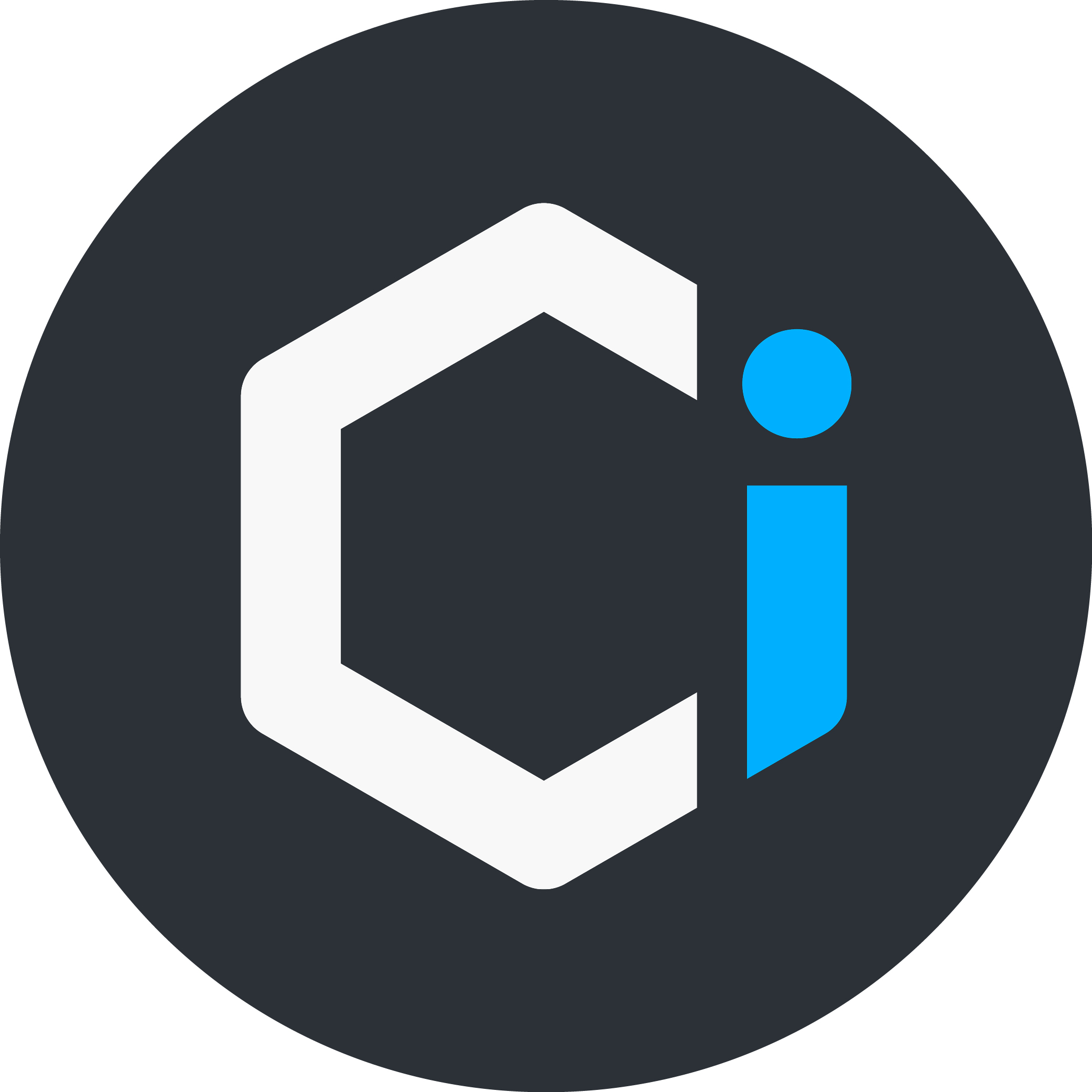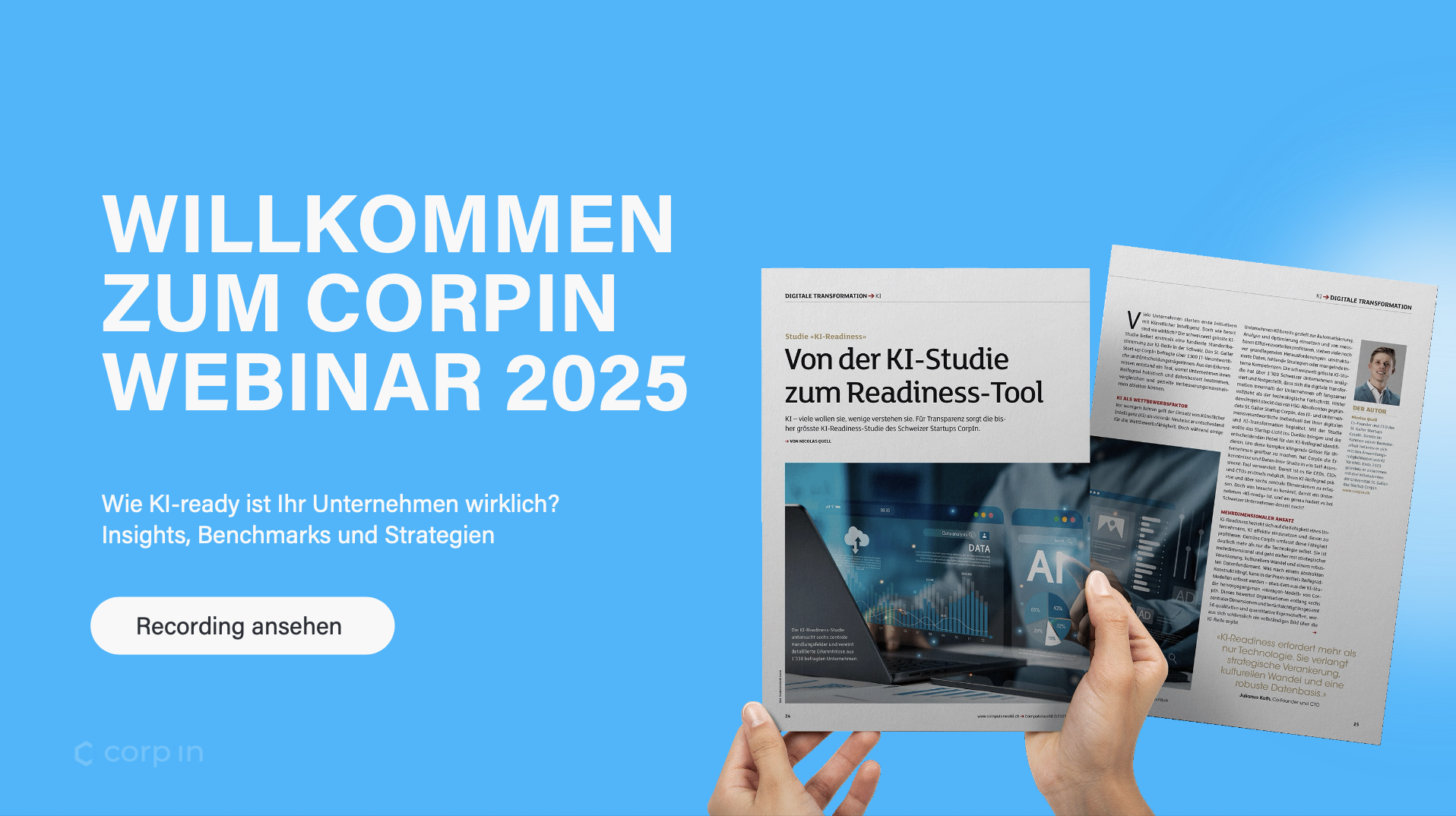Webinar review: How AI-ready is your company really? - Insights, benchmarks, strategies

Authored by

July 24, 2025
On July 24, 2025, the CorpIn webinar "How AI-ready is your company really? Insights, benchmarks, strategies" took place successfully. Numerous decision-makers from a wide range of industries and company sizes - from up-and-coming SMEs to established corporations - took part. This impressive diversity of participants underlines the great cross-thematic relevance of AI readiness. At a time when artificial intelligence has long since become a reality in companies, the question arises as to how well prepared companies in Switzerland really are for AI. The webinar offered valuable insights into the state of digital transformation and showed why AI readiness is becoming a decisive success factor in the modern corporate world. Many thanks to everyone who attended and contributed to the success of this event with their questions and discussions!
Study Insights
Right at the beginning, key results of the current AI maturity study 2025 were presented. This Swiss study - the Swiss AI Report 2025 - is based on a survey of 1,338 companies and examines AI readiness in Switzerland along six dimensions. The figures speak for themselves and illustrate where opportunities and construction sites lie:
- Data quality as an Achilles heel: Only 8% of companies have a fully consistent data structure - so the database is often incomplete. Without clean, integrated data, every AI strategy suffers, because even the smartest AI cannot deliver added value if the data basis is not correct.
- Strategy vs. implementation: 65% of companies have anchored AI in their long-term strategy, but only 13% have defined clear, measurable goals or KPIs. In other words, while AI is a priority on paper, it often remains a buzzword without concrete implementation. This gap between ambition and reality hampers the success of AI initiatives - goals and responsibilities remain vague and progress is difficult to measure.
- Lack of success measurement: More than half (around 51%) of companies do not measure the success of AI projects at all. Without key figures and ongoing monitoring, there is no basis for making strategic decisions based on data. As a result, AI projects run the risk of working away without visibility, which makes it difficult to anchor them in the company in the long term.
- Skills gaps in the team: Only 9% of companies offer their employees mandatory, regular AI training. This means that there are still gaps in the development of AI skills. At the same time, 39% of companies do not have an AI specialist on their team. This skills gap slows down the implementation of AI: without internal expertise, potential is not recognized and external service providers cannot be managed effectively.
- Initial successes and stragglers: 48% of Swiss companies are already using AI in initial processes - an increase of ~10% compared to 2023. This shows that AI is slowly moving from hype to practice. Nevertheless, a good half are still not using AI in their day-to-day operations. Many companies are still in the experimental or planning phase, while the pioneers are already realizing their first efficiency gains.
- Technical integration is lacking: 40% of companies lack end-to-end IT integration for AI solutions. Specialized systems - from BI to SCM - are often not yet connected to AI. Accordingly, 64% of companies cite the lack of integration into existing systems as a key AI obstacle. Technical barriers are evident here: AI analyses remain ineffective if they do not feed back into core processes (e.g. ERP/CRM).
Conclusion of the study: Swiss companies' AI readiness is improving, but there is still a lot of homework to be done. Data silos, a lack of a clear strategy, insufficient skills and integration problems are still slowing things down in many cases. Artificial intelligence in Swiss companies is currently evolving from buzzword to concrete practice - now it's time to close the gaps and put AI on a solid strategic footing.
The Hexagon model in detail
A highlight of the webinar was the presentation of the Hexagon Model - a six-dimensional AI maturity model that was developed as part of the study. This model summarizes six central fields of action that together provide a holistic picture of a company's AI readiness. Why Hexagon? Because each field of action contributes to the overall maturity like a building block (one side of the hexagon). In the webinar, the six maturity dimensions were explained with practical examples:
- Data foundation: "Data is the new oil " - the quality of AI applications depends directly on the quality of your data. This field is about data quality, availability and structure. Example: A company with consolidated, cleansed data can run reliable analyses; one with isolated data silos, on the other hand, struggles with inconsistent results. Implication: Investments in data management (from cleansing to governance) are a basic prerequisite for AI to develop its potential.
- Strategic anchoring: AI projects need the backing of management and clear objectives. This dimension assesses whether AI is strategically embedded - including top management support, defined KPIs and continuous monitoring of success. Example: Company A has an AI roadmap with measurable goals, board sponsorship and regular reporting; company B experiments ad hoc without a strategy. Unsurprisingly, A is more successful, because without a strategy, AI remains piecemeal.
- Organizational culture: "Culture eats strategy for breakfast " - this also applies to AI. An innovation-friendly, open culture is a decisive factor in whether AI initiatives are accepted. Here we look at employee acceptance, change management and willingness to learn. Example: In a culture that rewards experimentation and reduces fears through open communication, employees are more likely to see AI as an opportunity rather than a threat. Tip: Transparent communication ("What are the benefits of AI for each individual?") and team involvement in pilot projects promote trust.
- Technical requirements: This refers to infrastructure, systems and integration - in short, the IT capabilities that make AI possible in the first place. These include scalable cloud platforms, sufficient computing capacity and, above all, the seamless integration of AI solutions into the existing system landscape. Example: A company with flexible APIs and modern architecture can easily dock an AI service and embed it in business processes. If this foundation is missing, AI often remains stuck in isolated solutions.
- Security & privacy: Every new technology also brings risks - this is about data protection, IT security and compliance. AI systems must be used responsibly, especially when it comes to sensitive data. Example: A financial company must ensure that AI models do not breach confidential customer data; guidelines (e.g. GDPR-compliant data use) and technical measures (encryption, access restriction) are therefore required. Companies that integrate security & compliance at an early stage avoid nasty surprises later on and still use AI effectively.
- Awareness & competence: Finally, the model evaluates the know-how and awareness of AI in the company. Does the organization understand AI? Do we have the necessary skills or access to them?These factors determine whether AI initiatives can be expertly planned and implemented. Example: Company X regularly trains its employees in the basics of AI and has data scientists in the team - new application ideas are quickly generated there through internal knowledge. Company Y, on the other hand, lacks an understanding of AI; here there is a risk of overlooking opportunities or being blinded by hype.
Overview: In the webinar, the hexagon model proved to be a structured framework for making the various aspects of AI readiness tangible. The participants were able to immediately identify themselves in the dimensions ("Where do we stand in terms of data? How open is our culture really?") and recognize in which areas their own company has strengths or weaknesses. This holistic view is crucial: AI readiness requires more than just technology - it is an interplay of data, people, processes and structure.
Challenges for companies
In the next section, the speakers openly discussed the biggest hurdles that companies have to overcome on the way to high AI readiness. Five key challenges emerged from the study and practice that almost every company has to face:
- Data & quality: garbage in, garbage out. Many companies struggle with poor data quality and fragmented data sources. If data is scattered, incomplete or outdated, AI algorithms cannot exploit its potential. The challenge is to consolidate data, break down silos and create a reliable database - a fundamental but often underestimated task.
- Strategy & clarity of objectives: As the study shows, there is often a lack of clear strategic anchoring of AI. Companies find it difficult to define concrete goals, KPIs and responsibilities for AI initiatives. As a result, AI projects lose focus or fizzle out. The appeal is not just to adopt AI as a trend, but to actively embed it in the business strategy - with a clear why and what (goals) behind every AI project.
- Integration into processes: System integration was identifiedby the participants as a technical bottleneck. AI solutions often run in isolation and are not linked to core processes. 64% of the companies surveyed cited a lack of integration as the main problem. It is important to modernize the IT architecture, create interfaces (APIs, middleware) and reduce isolated solutions. Only in this way can AI findings flow seamlessly into the business process - for example, by a chatbot writing directly into the CRM system or an AI analysis automatically ending up in reporting.
- Culture & change management: Corporate culture also poses a challenge. 41% of companies report resistance or reluctance within the team towards AI projects. Even if only a few employees are openly skeptical, there are often silent reservations, fears and uncertainties. Employees ask themselves: Will I lose my job as a result of AI? How will I change the way I work? Without active change management and early involvement of the workforce, such cultural barriers can put the brakes on projects. Transparency, training and participation are the keys to establishing an AI-friendly culture.
- Skills & talents: After all, many companies lack the necessary specialists and skills to drive AI forward. The lack of AI experts and suitable training opportunities was clearly identified in the webinar. 39% of companies do not have an AI specialist on board, and over half provide their employees with little or only sporadic training in AI. This know-how gap makes it difficult to design, manage or even assess AI projects internally. The challenge is to build up AI skills in a targeted manner - whether through further training for existing employees (e.g. data literacy for managers) or by recruiting specialists. In the long term, such an investment in human capital pays off in order to become less dependent on external help.
To summarize: On the road to AI excellence, companies in Switzerland are faced with a bundle of tasks that need to be tackled in an interdisciplinary manner. Data, strategy, integration, culture and skills - all of these areas need attention. The good news is that no company is alone in facing these challenges. In the webinar, many questions were asked, best practices were shared and encouragement was given to tackle these challenges step by step. Every journey, no matter how big, begins with the first step - and this is exactly what the rest of the webinar provided concrete approaches for.
The hexagon tool as a guide
A practical tool was also presented during the webinar: the new Hexagon platform from CorpIn - a self-assessment tool that accompanies companies step by step on their path to greater AI maturity. This Swiss tool with an empirical foundation is based on the data from the aforementioned study (over 1,300 data sets from Swiss companies) and makes the level of AI maturity comprehensively measurable for the first time. What exactly does Hexagon offer?
- Clear assessment: The platform allows you to evaluate your own AI readiness along the six dimensions of the Hexagon model. Based on 56 success factors, you receive a detailed assessment of your strengths and weaknesses. Instead of vague assumptions, there are objective facts about where your company stands today.
- Objective benchmarking: How does your company compare to others in the industry? Hexagon provides benchmarks against similar companies (same industry, same size) based on one of the largest AI databases in Switzerland. You can see, for example, whether your AI strategy is above or below the industry average, or how your data quality compares to others. This data-based benchmarking creates clarity and urgency by showing where you stand relative to the market.
- Concrete recommendations for action: The tool derives individual fields of action and recommendations from the results. You will find out specifically which next steps will have the greatest impact. For example, the tool could recommend prioritizing the expansion of the data infrastructure (if weaknesses have been identified there) or setting up a training program if employee competence has been rated conspicuously low. These tailor-made recommendations serve as a strategic basis for tackling measures with the greatest leverage first.
Hexagon also scores points with its intuitive visualization: all results are displayed in clear dashboards, for example as a hexagonal radar chart that shows your profile at a glance. This allows you to immediately recognize in which dimension there is a need to catch up. Decision-makers get a holistic yet tangible picture of their company's AI maturity - ideal as a starting point for further discussions within the management team.
Note: The Hexagon platform was demonstrated live in the webinar. Many participants were impressed by how quickly and easily they could carry out an AI maturity check. As a Swiss solution developed in St. Gallen, Hexagon also guarantees that data is processed securely and in compliance with the GDPR - a not insignificant aspect when thinking about benchmarking with company data.
The bottom line is that Hexagon is a signpost: instead of blindly launching AI projects, companies can use this tool to plan and prioritize based on data. It takes away a lot of uncertainty and provides a clear roadmap of where to start. Or to put it in the words of the CorpIn CEO, who was quoted in the webinar: "Many companies don't even know how prepared they really are. With the Hexagon platform, we make exactly that visible - and show where to start."
Your next steps
After all the insights, figures and tools, the question of all questions is: What should we do now? The webinar review would not be complete without a clear roadmap for your next steps. Here is a possible action plan that we recommend to decision-makers - from knowledge to action:
- Watch the webinar recording: If you were unable to attend the live event or would like to listen to certain passages again, catch up on the insights! The recording of the webinar is now available. Take an hour and let the most important points (study results, use cases, tool demo) sink in. (Tip: Share the recording with colleagues to create a common understanding).
- Analyze the status quo - carry out a Hexagon self-assessment: Do you know where your company stands in terms of AI readiness? Be honest with yourself. Use the Hexagon platform today to determine your current maturity level. It won't take long and will provide you with an objective report covering all six dimensions - including benchmarks and initial recommendations. Interested? Click here for the tool: Determine AI maturity level now!
- Discuss findings internally: Present the results of your maturity level analysis to the management team. Where are your strengths, where is urgent action needed? Discuss the priorities together: Perhaps it turns out that data quality is the most urgent issue - or that an AI strategy needs to be adopted at top management level. Use the Hexagon results as the basis for a roadmap.
- Derive concrete measures: Develop an AI roadmap based on the identified fields of action. Set yourself SMART goals (e.g.: "By the end of the year, we will create consolidated customer data in a cloud platform" or "We will train 100 employees in AI basics"). Prioritize measures according to impact: What brings the greatest benefit or minimizes the greatest risk? Define responsibilities and budgets. It can be helpful here to follow best practices or consult an experienced partner such as CorpIn to strategically coordinate the measures.
- Start pilot projects: Think big, start small. Identify one or two pilot use cases that can be implemented quickly and promise success - such as a chatbot in customer service or automated data analysis in a sub-process. These pilots serve as a learning field: you gain experience, gain internal supporters through quick wins and can try out what works and what doesn't at low risk. Important: Define success criteria (KPIs) for each pilot project from the outset in order to make the added value measurable.
- Measure and iterate progress: AI readiness is an ongoing process, not a one-off project. Therefore, establish a control loop: measure progress regularly (e.g. a new Hexagon assessment every 6-12 months as a benchmark), adapt your strategy to new findings and gradually scale successful pilots to the entire company. Celebrate successes, learn from setbacks and remain agile. Over time, your company will develop from an AI newcomer to an AI pioneer.
The following applies at all times: Don't stay alone! Network with others, share experiences (e.g. via LinkedIn groups or industry associations) and get expert advice if necessary. The AI community - especially in Switzerland - is growing rapidly, and mutual support can make many things easier.
Outlook & thanks
Finally, we would like to take a look ahead - and say thank you. The lively participation and positive feedback on the webinar have shown that AI readiness in Switzerland is a key topic that concerns many. Now is the time to move from knowledge to action. Take advantage of the resources provided: download the full Swiss AI Report 2025 for free to get even more insights and best practices. Watch the webinar recording and share it internally to kick-start the change together. And above all: start your own AI initiative now, not "someday". If you ask the right questions today and invest boldly in AI, you will be a winner tomorrow.
We would like to thank all participants for their trust and commitment. Your interest in our webinar motivates us to continue sharing knowledge, inspiring and developing solutions together. Stay tuned - this was certainly not our last event on AI and digital transformation. The future belongs to the companies that act now. With this in mind, let's get to work and make our companies fit for the future of AI! 🚀
The content of this article may have been improved with the help of artificial intelligence. Therefore, we cannot guarantee that all information is complete and error-free.



